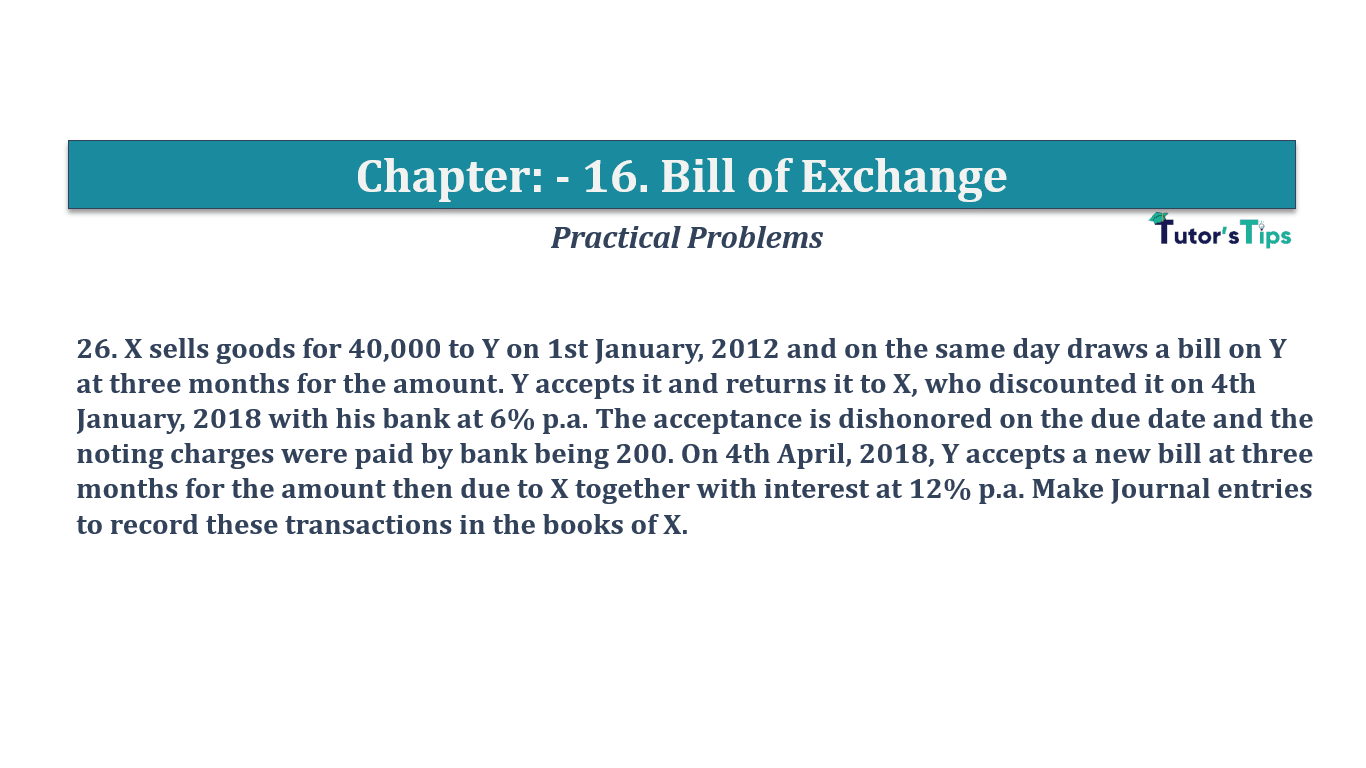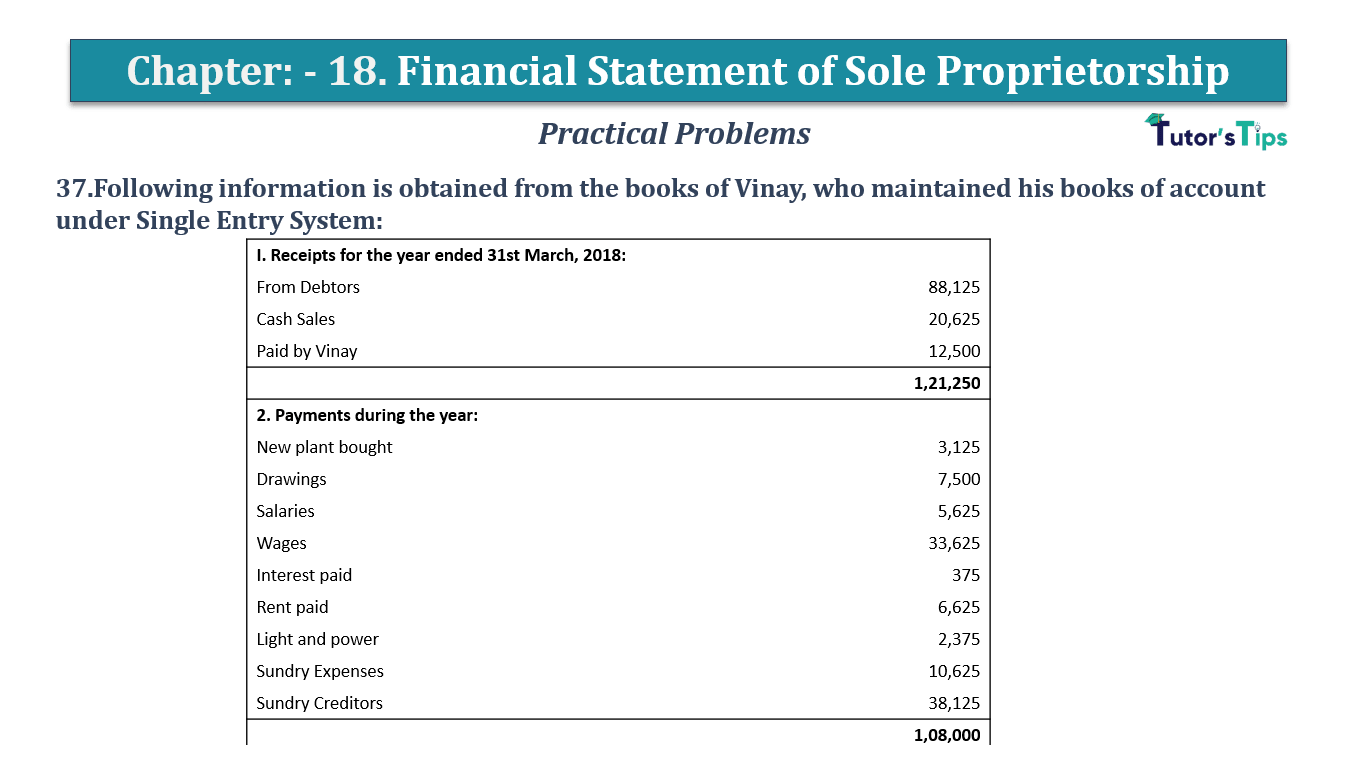Advertisement
Question No 26 Chapter No 16
Advertisement
26. X sells goods for 40,000 to Y on 1st January 2012 and on the same day draws a bill on Y at three months for the amount. Y accepts it and returns it to X, who discounted it on 4th January 2018 with his bank at 6% p.a. The acceptance is dishonoured on the due date and the noting charges were paid by the bank is 200. On 4th April 2018, Y accepts a new bill at three months for the amount then due to X together with interest at 12% p.a. Make Journal entries to record these transactions in the books of X.
The solution of Question No 26 Chapter No 16: –
Books of A | |||||
| Date | Particulars | L.F. | Debit | Credit | |
| 2012 | |||||
| Jan.01 | Y A/c | Dr. | 40,000 | ||
| To Sales A/c | 40,000 | ||||
| (Being Good sold to Y) | |||||
| Jan.01 | Bills Receivable A/c | Dr. | 40,000 | ||
| To Y A/c | 40,000 | ||||
| (Being B′s acceptance received and discount allowed) | |||||
| Jan.04 | Bank A/c | Dr. | 39,400 | ||
| Discounting Charges A/c | Dr. | 600 | |||
| To Bills Receivable A/c | 40,000 | ||||
| (Being Bill discounted ) | |||||
| Apr.04 | Y A/c * | Dr. | 40,200 | ||
| To Bank A/c | 40,200 | ||||
| (Being Bill dishonoured and noting charges of Rs 200 paid by the bank) | |||||
| Apr.04 | Y A/c ** | Dr. | 1,206 | ||
| To Bank A/c | 1,206 | ||||
| (Being Interest due for three months from Nonrenewal of the bill) | |||||
| Apr.04 | Bills Receivable New A/c | Dr. | 41,406 | ||
| To Y A/c | 41,406 | ||||
| (Being Acceptance received from Y`) | |||||
Working Notes:
Advertisement-X
| Calculation of Discount charges | = | Bills receivable | X | Rate | X | Period of Maturity |
| 100 | 12 |
| 40,000 | X | 6 | X | 3 |
| 100 | 12 |
= Rs 200
| 40,.200 | X | 12 | X | 3 |
| 100 | 12 |
= Rs 1,206
Bill of exchange (BOE): Meaning and Examples
Thanks, Please Like and share with your friends
Comment if you have any question.
Also, Check out the solved question of previous Chapters: –
Advertisement-X
- Chapter No. 1 – Introduction to Accounting
- Chapter No. 2 – Basic Accounting Terms
- Chapter No. 3 – Theory Base of Accounting, Accounting Standards and International Financial Reporting Standards(IFRS)
- Chapter No. 4 – Bases of Accounting
- Chapter No. 5 – Accounting Equation
- Chapter No. 6 – Accounting Procedures – Rules of Debit and Credit
- Goods and Services Tax(GST)
- Chapter No. 7 – Origin of Transactions – Source Documents and Preparation of Vouchers
- Chapter No. 8 – Journal
- Chapter No. 9 – Ledger
- Chapter No. 10 – Special Purpose Books I – Cash Book
- Chapter No. 11 – Special Purpose Books II – Other Books
- Chapter No. 12 – Bank Reconciliation Statement
- Chapter No. 13 – Trial Balance
- Chapter No. 14 – Depreciation
- Chapter No. 15 – Provisions and Reserves
- Chapter No. 16 – Accounting for Bills of Exchange
- Chapter No. 17 – Rectification of Errors
- Chapter No. 18 – Financial Statements of Sole Proprietorship
- Chapter No. 19 – Adjustments in preparation of Financial Statements
- Chapter No. 20 – Accounts from incomplete Records – Single Entry System
- Chapter No. 21 – Computers in Accounting
- Chapter No. 22 – Accounting Software – Tally
- Chapter No. 5 – Accounting Equation
- Chapter No. 6 – Accounting Procedures – Rules of Debit and Credit
- Goods and Services Tax(GST)
- Chapter No. 8 – Journal
- Chapter No. 9 – Ledger
- Chapter No. 10 – Special Purpose Books I – Cash Book
Check out T.S. Grewal +1 Book 2019 @ Official Website of Sultan Chand Publication
Advertisement-Y












Leave a Reply